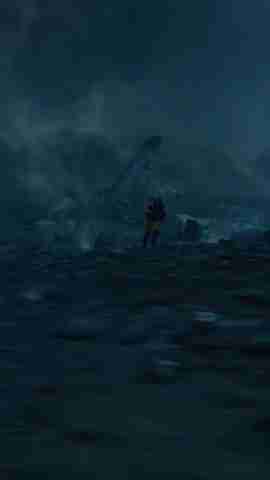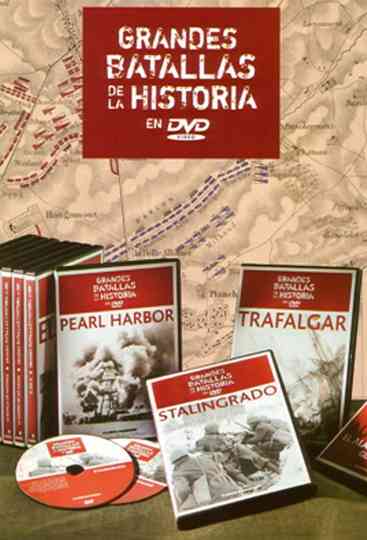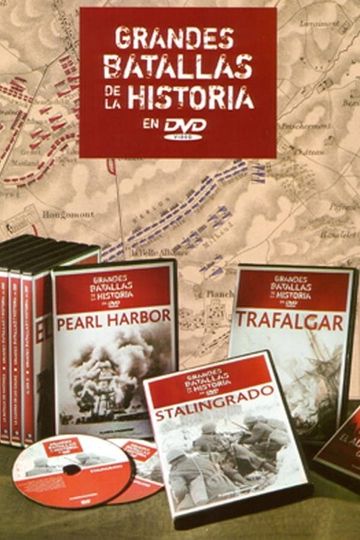Season 1 Plot
A series profiling key campaigns and battles in military history.
Great Battles in History Season 1 aired on July 2nd, 2009.
Season 1 Episodes
1. Stalingrad - 1942
A series giving a bird's-eye view of some of the bloodiest battles in history. This programme looks at a pivotal point of the Second World War, when the Russian army stopped the Nazi advance at Stalingrad
2. Trafalgar 1805
Trafalgar is perhaps the most famous naval engagement in military history. Admiral Lord Nelson's victory over a combined fleet of French and Spanish ships put an end to Napoleon's dream of invading England. Follow the strategy of the famous battle that killed Britain's most famous naval hero.
3. Pearl Harbour
The attack on Pearl Harbor was a surprise military strike by the Imperial Japanese Navy Air Service upon the United States against the U.S. naval base at Pearl Harbor in Honolulu, Hawaii, just before 8:00 a.m. on Sunday, December 7, 1941.
4. The Battle of Marathon
The Battle of Marathon was an armed confrontation that defined the outcome of the first medical war. It happened in the year 490 a. C. and took place in the fields and the beach of the city of Marathon, located a few kilometers from Athens, on the east coast of Attica. He faced on the one hand the Persian king Darius I, who wanted to invade and conquer Athens for his participation in the Ionian revolt, and, on the other hand, the Athenians and their allies (from Plataea, among others). A feat remembered in this battle by Herodotus was that of Pheidippides, who walked the road from Athens to Sparta to ask for help from the Spartan army. Sparta refused to help the Athenians, claiming to meet on dates of religious celebrations.
5. The Lost Evidence of Iwo Jima
The Battle of Iwo Jima (19 February – 26 March 1945) was a major battle in which the United States Marine Corps (USMC) and United States Navy (USN) landed on and eventually captured the island of Iwo Jima from the Imperial Japanese Army (IJA) during World War II. The American invasion, designated Operation Detachment, had the purpose of capturing the island with its two airfields: South Field and Central Field.
6. D-Day
The Normandy landings were the landing operations and associated airborne operations on Tuesday, 6 June 1944 of the Allied invasion of Normandy in Operation Overlord during World War II. Codenamed Operation Neptune and often referred to as D-Day, it was the largest seaborne invasion in history. The operation began the liberation of France (and later Western Europe) and laid the foundations of the Allied victory on the Western Front.
7. The Battle of Waterloo - 1815
Series giving a bird's-eye view of some of the bloodiest battles in history. This edition looks at how Wellington's positioning of his men out of the line of fire broke with centuries of military tradition - and changed the course of European history forever.
8. Chalons
The Battle of the Catalaunian Plains (or Fields), also called the Battle of the Campus Mauriacus, Battle of Châlons, Battle of Troyes or the Battle of Maurica, took place on June 20, 451 AD, between a coalition – led by the Roman general Flavius Aetius and by the Visigothic king Theodoric I – against the Huns and their vassals – commanded by their king Attila. It proved one of the last major military operations of the Western Roman Empire, although Germanic foederati composed the majority of the coalition army.
9. Battle of Hastings 1066
Documentary series giving a close-up view of some of the bloodiest battles in history. This edition examines the meeting of Harold and William the Conqueror at Hastings in 1066, which changed the Anglo-Saxon world for ever.
10. Merrill’s Marauders
Merrill’s Marauders (named after Frank Merrill) or Unit Galahad, officially named the 5307th Composite Unit (Provisional), was a United States Army long range penetration special operations jungle warfare unit, which fought in the Southeast Asian theater of World War II, or China-Burma-India Theater (CBI). The unit became famous for its deep-penetration missions behind Japanese lines, often engaging Japanese forces superior in number.
11. The Battle of Austerlitz
The Battle of Austerlitz (2 December 1805/11 Frimaire An XIV FRC), also known as the Battle of the Three Emperors, was one of the most important and decisive engagements of the Napoleonic Wars. The battle occurred near the town of Austerlitz in the Austrian Empire (modern-day Slavkov u Brna in the Czech Republic). The decisive victory of Napoleon's Grande Armée at Austerlitz brought the War of the Third Coalition to a rapid end, with the Treaty of Pressburg signed by the Austrians later in the month. The battle is often cited as a tactical masterpiece.
12. Gallipoli
During World War I (1914-1918), French, British, and allied forces (Australian, New Zealand, Newfoundland, Irish and Indian) fought the Gallipoli campaign (1915-1916) in and near the peninsula, seeking to secure a sea route to relieve their eastern ally, Russia. The Ottomans set up defensive fortifications along the peninsula and contained the invading forces.
13. Midway
The Battle of Midway was a major naval battle in the Pacific Theater of World War II that took place from 4–7 June 1942, six months after Japan's attack on Pearl Harbor and one month after the Battle of the Coral Sea.
14. The Battle of Gettysburg - 1863
Series giving a close-up view of some of the bloodiest battles in history. This edition focuses on the three-day bloodbath at Gettysburg which was a turning point in the American Civil War.
15. The Armada - 1588
The English Armada (Spanish: Invencible) known as the Counter Armada or the Drake–Norris Expedition, was an attack fleet sent against Spain by Queen Elizabeth I of England that sailed on 28 April 1589 during the undeclared Anglo-Spanish War (1585–1604) and the Eighty Years' War.
16. Battle of the Bulge
The Battle of the Bulge, also known as the Ardennes Offensive, was the last major German offensive campaign on the Western Front during World War II. The battle lasted for five weeks from 16 December 1944 to 28 January 1945, towards the end of the war in Europe.
17. The Third Crusade
The Third Crusade (1189–1192) was an attempt led by three European monarchs of Western Christianity (Philip II of France, Richard I of England and Frederick I, Holy Roman Emperor) to reconquer the Holy Land following the capture of Jerusalem by the Ayyubid sultan Saladin in 1187. For this reason, the Third Crusade is also known as the Kings' Crusade.
18. The battle of Alesia
The battle of Alesia or siege of Alesia (September 52 BC) was the climactic military engagement of the Gallic Wars, fought around the Gallic oppidum (fortified settlement) of Alesia in modern France, a major centre of the Mandubii tribe. It was fought by the Roman army of Julius Caesar against a confederation of Gallic tribes united under the leadership of Vercingetorix of the Arverni. It was the last major engagement between Gauls and Romans, and is considered one of Caesar's greatest military achievements and a classic example of siege warfare and investment; the Roman army built dual lines of fortifications – an inner wall to keep the besieged Gauls in, and an outer wall to keep the Gallic relief force out. The Battle of Alesia marked the end of Gallic independence in the modern day territory of France and Belgium.
19. Cannae
The Battle of Cannae was a key engagement of the Second Punic War between the Roman Republic and Carthage, fought on 2 August 216 BC near the ancient village of Cannae in Apulia, southeast Italy. The Carthaginians and their allies, led by Hannibal, surrounded and practically annihilated a larger Roman and Italian army under the consuls Lucius Aemilius Paullus and Gaius Terentius Varro. It is regarded as one of the greatest tactical feats in military history and one of the worst defeats in Roman history.
20. The Six-Day War
A series giving a close-up view of various battles in history. This edition recalls the crisis in the Middle East in June 1967, when tension on three borders escalated into a full-scale war between Israel and her Arab neighbours.
21. The Battle of Britain
The Battle of Britain (The air battle for England), was a military campaign of the Second World War, in which the Royal Air Force (RAF) and the Fleet Air Arm (FAA) of the Royal Navy defended the United Kingdom (UK) against large-scale attacks by Nazi Germany's air force, the Luftwaffe. It was the first major military campaign fought entirely by air forces.
22. Battle of Kadesh - Ramesses II
The Battle of Kadesh or Battle of Qadesh took place between the forces of the New Kingdom of Egypt under Ramesses II and the Hittite Empire under Muwatalli II at the city of Kadesh on the Orontes River, just upstream of Lake Homs near the modern Lebanon–Syria border. The battle is generally dated to 1274 BC from the Egyptian chronology, and is the earliest pitched battle in recorded history for which details of tactics and formations are known. It is believed to have been the largest chariot battle ever fought, involving between 5,000 and 6,000 chariots in total.
23. The Battle of Agincourt
The Battle of Agincourt was an English victory in the Hundred Years' War. It took place on 25 October 1415 (Saint Crispin's Day) near Azincourt, in northern France.[b] The unexpected English victory against the numerically superior French army boosted English morale and prestige, crippled France, and started a new period of English dominance in the war that would last for 14 years until France defeated England in the Siege of Orléans in 1429.
24. The Battle of Inchon
The Battle of Inchon, also spelled Battle of Incheon, was an amphibious invasion and a battle of the Korean War that resulted in a decisive victory and strategic reversal in favor of the United Nations Command (UN). The operation involved some 75,000 troops and 261 naval vessels and led to the recapture of the South Korean capital of Seoul two weeks later. The code name for the operation was Operation Chromite.
25. Tobruk
The Siege of Tobruk was a siege imposed by the Axis Forces for 240 days on the town-fortress and Allied port of Tobruk in 1941, in the context of World War II. The siege began on April 10, when a German-Italian force led by Erwin Rommel attacked Tobruk, placing the city under a siege that would continue until November 27, when British 8th Army forces lifted the siege during Operation Crusader.
26. Little Bighorn
The Battle of the Little Bighorn, known to the Lakota and other Plains Indians as the Battle of the Greasy Grass, and commonly referred to as Custer's Last Stand, was an armed engagement between combined forces of the Lakota Sioux, Northern Cheyenne, and Arapaho tribes and the 7th Cavalry Regiment of the United States Army. The battle, which resulted in the defeat of U.S. forces, was the most significant action of the Great Sioux War of 1876.
27. Cambrai 1917
The Battle of Cambrai (Battle of Cambrai, 1917 was a British attack in the First World War, followed by the biggest German counter-attack against the British Expeditionary Force (BEF) since 1914.
28. Operation Desert Storm
The Gulf War was a 1990–1991 armed campaign waged by a 39-country military coalition in response to the Iraqi invasion of Kuwait. Spearheaded by the United States, the coalition's efforts against Iraq were carried out in two key phases: Operation Desert Shield, which marked the military buildup from August 1990 to January 1991; and Operation Desert Storm, which began with the aerial bombing campaign against Iraq on 17 January 1991 and came to a close with the American-led Liberation of Kuwait on 28 February 1991.
29. The Great War
World War I or the First World War (28 July 1914 – 11 November 1918), often abbreviated as WWI, was one of the deadliest global conflicts in history. It was fought between two coalitions, the Allies (primarily France, the United Kingdom, Russia, Italy, Japan, and the United States) and the Central Powers (led by Germany, Austria-Hungary, and the Ottoman Empire). Fighting occurred throughout Europe, the Middle East, Africa, the Pacific, and parts of Asia. An estimated 9 million soldiers were killed in combat, plus another 23 million wounded, while 5 million civilians died as a result of military action, hunger, and disease. Millions more died as a result of genocide, while the 1918 Spanish flu pandemic was exacerbated by the movement of combatants during the war.
30. Saratoga and The Battle of Rivoli
The Battles of Saratoga (September 19 and October 7, 1777) marked the climax of the Saratoga campaign, giving a decisive victory to the Americans over the British in the American Revolutionary War. British General John Burgoyne led an invasion army of 7,200–8,000 men southward from Canada in the Champlain Valley, hoping to meet a similar British force marching northward from New York City and another British force marching eastward from Lake Ontario; the goal was to take Albany, New York. The southern and western forces never arrived, and Burgoyne was surrounded by American forces in upstate New York 15 miles (24 km) short of his goal. He fought two battles which took place 18 days apart on the same ground 9 miles (14 km) south of Saratoga, New York. He gained a victory in the first battle despite being outnumbered, but lost the second battle after the Americans returned with an even larger force.
31. The Battle for Berlin
The Battle of Berlin, designated as the Berlin Strategic Offensive Operation by the Soviet Union, and also known as the Fall of Berlin, was one of the last major offensives of the European theatre of World War II.
32. The Battle of El Alamein
A series giving a bird's-eye view of some of the bloodiest battles in history. This edition looks at the crucial battle of El Alamein in 1942, a victory which stopped Rommel's Afrika Korps in its tracks and proved to be a major turning point in the war.
33. TET Ofenssive
The Tet Offensive was a major escalation and one of the largest military campaigns of the Vietnam War. It was launched on January 30, 1968 by forces of the Viet Cong (VC) and North Vietnamese People's Army of Vietnam (PAVN) against the forces of the South Vietnamese Army of the Republic of Vietnam (ARVN), the United States Armed Forces and their allies. It was a campaign of surprise attacks against military and civilian command and control centers throughout South Vietnam.
34. The Russo-Finnish War
The Winter War, also known as the First Soviet-Finnish War, was a war between the Soviet Union and Finland. The war began with a Soviet invasion of Finland on 30 November 1939, three months after the outbreak of World War II, and ended three and a half months later with the Moscow Peace Treaty on 13 March 1940. Despite superior military strength, especially in tanks and aircraft, the Soviet Union suffered severe losses and initially made little headway. The League of Nations deemed the attack illegal and expelled the Soviet Union from the organisation.
35. The Battle of Tannenberg
The Battle of Tannenberg, also known as the Second Battle of Tannenberg, was fought between Russia and Germany between 23 and 30 August 1914, the first month of World War I. The battle resulted in the almost complete destruction of the Russian Second Army and the suicide of its commanding general, Alexander Samsonov.
36. Life in the Trenches
Between two battles, life in the trenches was very hard for the combatants of the First World War, who, in addition to the hardships, the lack of hygiene, the rain, the lice and the rats, lived with the smell of death. In the summer of 1914 the combatants left for a "jovial war" of a few months, but from November, decimated by artillery, they buried themselves on the western front for four years of combat along a line of 700 km, from the North Sea to the Swiss border.
37. Monte Cassino 1944
The Battle of Monte Cassino, also known as the Battle for Rome and the Battle for Cassino, was a series of four military assaults made by the Allies against German forces in Italy during the Italian Campaign of World War II. The objective was to break through the Winter Line and facilitate an advance towards Rome.
38. Balaclava 1854
The Battle of Balaclava, fought on 25 October 1854 during the Crimean War, was part of the Siege of Sevastopol (1854–55), an Allied attempt to capture the port and fortress of Sevastopol, Russia's principal naval base on the Black Sea. The engagement followed the earlier Allied victory in September at the Battle of the Alma, where the Russian General Menshikov had positioned his army in an attempt to stop the Allies progressing south towards their strategic goal.
39. Guadalcanal
The Guadalcanal campaign, also known as the Battle of Guadalcanal and codenamed Operation Watchtower by American forces, was a military campaign fought between 7 August 1942 and 9 February 1943 on and around the island of Guadalcanal in the Pacific theater of World War II. It was the first major land offensive by Allied forces against the Empire of Japan.























